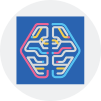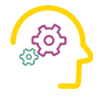
Master data science with our Hands-On Python & R Online Training Course. Gain practical skills in Python and R programming, data analysis, visualization, and machine learning. Engage in real-world projects and interactive lessons led by industry experts. Whether you're a beginner or looking to advance your expertise, this course equips you with the essential tools to excel in today’s data-driven world.
Hands-On Python & R In Data Science Interview Questions Answers - For Intermediate
1. What are the key differences between Python and R in the context of data science?
Python is a versatile, general-purpose language with extensive libraries like pandas and scikit-learn, making it suitable for various applications beyond data science. R is specifically designed for statistical analysis and visualization, offering comprehensive packages like ggplot2 and dplyr. Python emphasizes integration and deployment, while R excels in statistical modeling and exploratory data analysis.
2. Explain the concept of vectorization in both Python and R.
Vectorization refers to performing operations on entire arrays or vectors without explicit loops. In Python, libraries like NumPy enable vectorized operations, enhancing performance and efficiency. In R, vectorized functions allow for concise and efficient data manipulation. Vectorization leverages optimized low-level implementations, resulting in faster execution compared to iterative approaches.
3. How do Python and R handle data types differently in data frames?
In Python's pandas, DataFrames handle data types such as integers, floats, strings, and categorical data, with explicit type declarations. R's data frames also support similar types but treat factors distinctly for categorical variables. Additionally, R allows different data types across columns inherently, while pandas provide more control over type assignments and conversions.
4. Describe the role of libraries/packages in Python and R for data visualization.
In Python, libraries like Matplotlib, Seaborn, and Plotly facilitate diverse visualization needs, from basic plots to interactive dashboards. R’s ggplot2, part of the tidyverse, offers a grammar of graphics approach for creating complex and aesthetically pleasing visualizations. Both ecosystems provide extensive tools, but R is often preferred for statistical plots, while Python excels in integration with web applications.
5. What is the importance of the tidyverse in R, and how does it compare to Python’s data science stack?
The tidyverse is a collection of R packages (e.g., ggplot2, dplyr, tidyr) designed for data manipulation, visualization, and analysis with a unified syntax and philosophy. It promotes readable and efficient workflows. Python’s data science stack, including pandas, NumPy, and Matplotlib, offers similar functionalities but is more modular. Tidyverse emphasizes consistency and ease of use within R, whereas Python provides broader application versatility.
6, Explain the concept of data munging and how Python and R approach it.
Data munging involves cleaning and transforming raw data into a usable format. In Python, pandas provides functions like merge(), groupby(), and fillna() for these tasks. R utilizes packages like dplyr and tidyr for similar operations with functions such as filter(), select(), and spread(). Both languages offer robust tools, but R’s syntax is often considered more intuitive for data manipulation.
7. What are factors in R, and how do they differ from categorical variables in Python?
Factors in R are data structures used to represent categorical variables with a fixed set of levels. They are essential for statistical modeling and ensure consistent handling of categories. In Python, categorical data is typically managed using the category dtype in pandas, which serves a similar purpose but with different implementation details. Factors in R integrate deeply with its modeling functions, whereas Python’s approach is more flexible within the pandas framework.
8. Discuss the significance of scikit-learn in Python for machine learning compared to R’s caret package.
Scikit-learn is a comprehensive Python library for machine learning, offering tools for classification, regression, clustering, and model evaluation with a consistent API. R’s caret package provides similar functionalities, streamlining the process of training and tuning models across various algorithms. While scikit-learn is renowned for its integration with the broader Python ecosystem, caret is favored in R for its simplicity and extensive model support.
9. How do Python and R handle statistical modeling differently?
R is inherently designed for statistical analysis, offering a wide range of built-in functions and packages for complex statistical models and hypothesis testing. Python, while capable of statistical modeling through libraries like statsmodels and SciPy, generally emphasizes machine learning and general programming tasks. R provides more specialized tools and is often preferred for purely statistical tasks, whereas Python offers greater versatility for integrated data science workflows.
10. What is the role of Jupyter Notebooks in Python and RStudio in R for data science?
Jupyter Notebooks provide an interactive environment for Python (and other languages) where code, visualizations, and narrative text coexist, facilitating exploratory data analysis and sharing. RStudio serves a similar purpose for R, offering an integrated development environment (IDE) with tools for script editing, data visualization, and package management. Both platforms enhance productivity and collaboration by supporting reproducible research and interactive workflows.
11. Explain the concept of "tidy data" and how both Python and R support it.
Tidy data refers to a standardized format where each variable is a column, each observation is a row, and each type of observational unit forms a table. R supports tidy data through the tidyverse packages, particularly tidyr, and dplyr, which provide functions for reshaping and manipulating data. Python’s pandas also promote tidy data practices with similar functionalities, ensuring consistency and ease of analysis across both languages.
12. How do Python and R differ in handling large datasets?
Python, with libraries like pandas and Dask, efficiently handles large datasets through optimized memory management and parallel processing. R, traditionally limited by in-memory operations, has improved with packages like data. table and dplyr’s integration with databases. However, Python generally offers better scalability for extremely large datasets and integrates more seamlessly with big data tools and distributed computing frameworks.
13. What are the advantages of using object-oriented programming in Python for data science?
Object-oriented programming (OOP) in Python allows for the creation of reusable and modular code through classes and objects. This facilitates the organization of complex data workflows, encapsulation of functionalities, and inheritance for extending capabilities. In data science, OOP enables the development of custom models, pipelines, and tools, enhancing code maintainability and scalability compared to procedural programming approaches.
14. Describe the use of regular expressions in data preprocessing in both Python and R.
Regular expressions (regex) are patterns used to match and manipulate text data. In Python, the re-module provides extensive regex functionalities for searching, replacing, and parsing strings. R offers similar capabilities through functions like grep(), gsub(), and the string package. Regex is essential for tasks such as data cleaning, extraction, and transformation, allowing precise and flexible handling of textual data in both languages.
15. How do Python and R approach parallel computing and performance optimization in data science?
Python utilizes libraries like multiprocessing, and concurrent. futures, and Dask for parallel computing, enabling the execution of tasks across multiple cores or distributed systems. R employs packages such as parallel, for each, and future for similar purposes. Performance optimization in Python often involves using optimized libraries (e.g., NumPy) and just-in-time compilers like Numba, while R focuses on efficient data structures and vectorized operations to enhance speed and efficiency.
16. What is the importance of data serialization, and how do Python and R handle it?
Data serialization converts data structures into a format for storage or transmission. Python uses formats like JSON, Pickle, and CSV through modules such as json and pickle. R handles serialization with formats like RDS, JSON, and CSV using functions like saveRDS() and jsonlite. Serialization is crucial for data persistence, sharing, and interoperability between different systems and applications in both languages.
17. Explain the concept of functional programming in Python and R and its relevance to data science.
Functional programming involves using functions as first-class objects, enabling higher-order functions, immutability, and declarative code. In Python, functions like map(), filter(), and lambda expressions support functional paradigms. R inherently supports functional programming with features like anonymous functions, apply() family functions, and closures. This approach enhances code readability, reusability, and parallelism, which are beneficial for complex data transformations and analyses.
18. How do Python and R manage package dependencies and environments for data science projects?
Python manages dependencies using tools like pip and virtual environments (venv, conda), allowing isolated environments for different projects. R handles package dependencies through CRAN, Bioconductor, and package management tools like Packrat and Renv for creating reproducible environments. Proper management ensures consistent package versions, reduces conflicts and facilitates collaboration by maintaining stable project environments in both ecosystems.
19. What are the common data input and output formats supported by Python and R in data science?
Both Python and R support a variety of data formats, including CSV, JSON, Excel, SQL databases, and XML. Python’s pandas and R’s readr or data. table provides functions to read and write these formats efficiently. Additionally, both languages can interface with big data formats like Parquet and HDF5, and support APIs for accessing web data. This versatility ensures seamless integration with diverse data sources and storage systems.
20. Discuss the role of exploratory data analysis (EDA) in data science and how Python and R facilitate it.
Exploratory Data Analysis (EDA) involves summarizing the main characteristics of data, often using visual methods, to uncover patterns, anomalies, and insights. Python facilitates EDA with libraries like pandas for data manipulation, Matplotlib and Seaborn for visualization, and statistical libraries for analysis. R enhances EDA through the tidyverse, ggplot2 for advanced visualizations, and specialized packages like summary tools. Both languages provide comprehensive tools to perform thorough and effective EDA.
Hands-On Python & R In Data Science Interview Questions Answers - For Advanced
1. Explain the differences and interoperability between Python’s pandas and R’s dplyr for data manipulation. Provide an example where integrating both can be advantageous.
Pandas and dplyr both offer powerful data manipulation capabilities but differ in syntax and performance nuances. Pandas is Python-based, offering flexibility with integration into machine learning pipelines, while dplyr provides a concise, readable syntax in R. Integrating both can leverage pandas for data preprocessing and dplyr for sophisticated statistical analysis, enhancing workflow efficiency.
2. How would you implement a machine learning pipeline in Python using scikit-learn and replicate it in R using caret? Highlight key similarities and differences.
In Python’s scikit-learn, a pipeline chains preprocessing steps and models using Pipeline objects. Similarly, R’s caret uses the train function with pre-processing parameters. Both facilitate streamlined workflows and hyperparameter tuning. Differences include syntax and specific functions; scikit-learn integrates seamlessly with Python’s ecosystem, whereas caret offers extensive model interfaces tailored for R’s statistical functions.
3. Describe how to optimize memory usage when handling large datasets in Python and R. Include specific techniques or libraries for each language.
In Python, use pandas’ dtype optimization, chunk processing, and libraries like Dask for parallel computing. In R, utilize data.table for efficient memory usage, fread for faster data loading, and memory-efficient data structures. Both languages benefit from removing unnecessary objects and leveraging in-place operations to minimize memory footprint when managing large datasets.
4. Compare and contrast the visualization capabilities of Python’s matplotlib/seaborn and R’s ggplot2. When would you choose one over the other?
Matplotlib and seaborn offer extensive customization and integration with Python’s ecosystem, ideal for interactive dashboards and web applications. R’s ggplot2 provides a grammar of graphics approach, enabling elegant and complex statistical visualizations with simpler syntax. Choose matplotlib/seaborn for Python-centric projects and ggplot2 when leveraging R’s statistical strengths and creating publication-quality plots.
5. How can you integrate Python and R within a single data science project? Provide tools or frameworks that facilitate this interoperability.
Integration can be achieved using tools like R’s reticulate package, allowing execution of Python code within R scripts, and Jupyter notebooks that support both languages via different kernels. Additionally, frameworks like Apache Arrow enable data sharing between Python and R seamlessly. These tools facilitate leveraging strengths of both languages, enhancing flexibility and functionality in a unified project environment.
6. Explain the process of deploying a machine learning model developed in Python and R to a production environment. Highlight any differences in deployment strategies.
In Python, deployment often uses Flask or FastAPI for creating APIs, Docker for containerization, and platforms like AWS or Heroku. R models can be deployed using plumber for APIs, RStudio Connect, or similar services. Differences include language-specific tools and libraries, with Python offering broader support for scalable web frameworks, while R focuses on seamless integration within statistical environments.
7. Discuss advanced feature engineering techniques in Python and R. How do libraries in each language support these techniques?
Advanced feature engineering includes techniques like polynomial features, interaction terms, and encoding categorical variables. In Python, scikit-learn’s PolynomialFeatures, pandas’ get_dummies, and featuretools for automated feature engineering are prominent. In R, caret’s preprocessing functions, dplyr for data manipulation, and packages like featureEngineering facilitate similar advanced techniques, supporting robust model inputs.
8. What are the best practices for ensuring reproducible research in Python and R data science projects?
Best practices include using version control with Git, creating virtual environments (Python’s venv or R’s renv), documenting code with comments and README files, and employing literate programming tools like Jupyter Notebooks for Python and RMarkdown for R. Additionally, containerization with Docker ensures consistent environments, while dependency management ensures all packages and versions are tracked.
9. Illustrate how to perform cross-validation and hyperparameter tuning in Python and R. Which libraries facilitate these processes in each language?
In Python, scikit-learn’s GridSearchCV and RandomizedSearchCV perform cross-validation and hyperparameter tuning. In R, caret’s train function offers similar capabilities with methods like grid and random search. Both languages support parallel processing to speed up these tasks. The primary difference lies in syntax and specific implementation details, but both provide robust tools for optimizing model performance.
10. How do Python and R handle parallel computing and what libraries or packages are used to implement parallelism in data science tasks?
Python utilizes libraries like multiprocessing, joblib, and Dask for parallel computing, enabling concurrent execution of tasks across multiple cores. R employs packages such as parallel, foreach, and future to distribute computations. Both languages support parallelism to enhance performance in data-intensive tasks, with Python offering seamless integration into its broader ecosystem and R providing specialized packages tailored for statistical operations.
Course Schedule
| Dec, 2025 | Weekdays | Mon-Fri | Enquire Now |
| Weekend | Sat-Sun | Enquire Now | |
| Jan, 2026 | Weekdays | Mon-Fri | Enquire Now |
| Weekend | Sat-Sun | Enquire Now |
Related Courses
Related Articles
- Why are the SAS® Certified Professionals High in Demand?
- Explore IBM App Connect Enterprise Training for Future Success!
- How AutoDesk Advance Steel Training Boosts Your Skills?
- Gain acquaintance on UI automation with RPA online training
- How Microsoft Azure Data Engineer [DP-203] Prepares You for Big Data, Streaming & Analytics
Related Interview
Related FAQ's
- Instructor-led Live Online Interactive Training
- Project Based Customized Learning
- Fast Track Training Program
- Self-paced learning
- In one-on-one training, you have the flexibility to choose the days, timings, and duration according to your preferences.
- We create a personalized training calendar based on your chosen schedule.
- Complete Live Online Interactive Training of the Course
- After Training Recorded Videos
- Session-wise Learning Material and notes for lifetime
- Practical & Assignments exercises
- Global Course Completion Certificate
- 24x7 after Training Support













 Join our Live Instructor-Led online classes delivered by industry experts
Join our Live Instructor-Led online classes delivered by industry experts